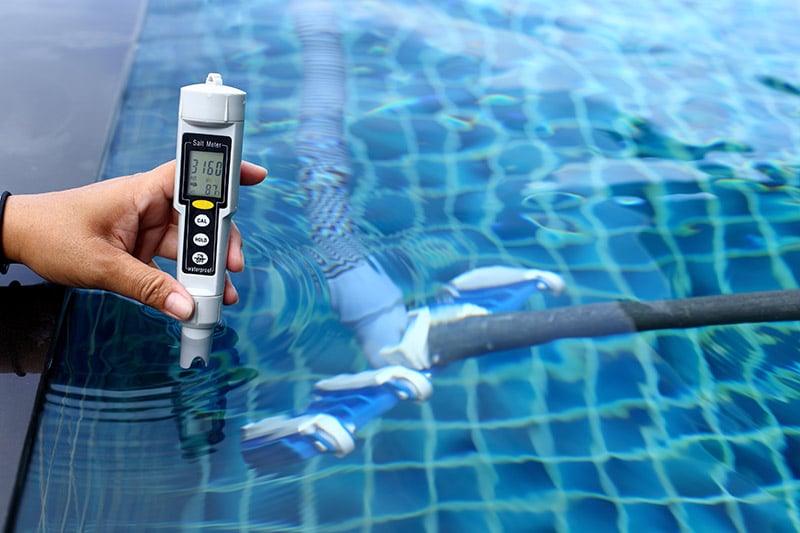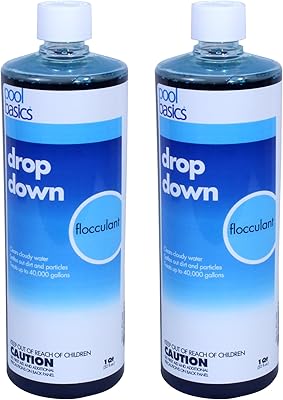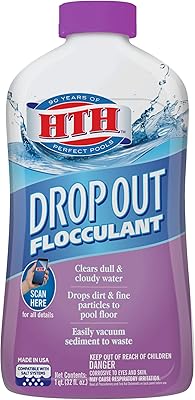A pool is a great place to relax, especially when it’s hot.
But what happens when it becomes cloudy and you want to have a swimming session as soon as possible?
Or when you have just planned an outdoor party with your friends only to realize your pool is full of algae?
The answer is, use a flocculant.
It is effective at getting rid of cloudiness and making the pool’s water super clear.
And the best thing about is that you don’t have to wait for an eternity before achieving what you want.
Here is all you need to know about this fast-working chemical.
What Is a Pool Flocculant?
A pool flocculant is a chemical that makes small particles in the pool clump together at its bottom to make it easy to vacuum them.
These small particles usually consist of viruses, algae spores, and bacteria.
Most of the time, the filter system of a pool makes the water clean but might not get rid of very small particles.
When you add a flocculant, the tiny particles form large pieces of dirt that you can easily see.
This makes it easy to get rid of them as they sink at the bottom.
It is an effective method of cleaning your pool when all the other methods have failed.
How To Floc A Pool
Below is a procedure on how to floc a pool.

1.Raise the Pool’s Water Level
Raising the pool’s water level is crucial since some of it will be lost during the vacuuming process.
If you don’t raise it, the water level will go below the filter system, which would prevent the pump from circulating the water effectively.
Add the water until it reaches the highest point by closing the outlet and opening the inlet.
2.Adjust the Water’s pH to About 7
Balance the water to a pH of around 7.
You can easily do this by adding sodium carbonate additives or acid, depending on the current pH.
Use a pool water test kit to test the pH.
Adjusting the pH to this level makes the flocculant work more effectively.
3.Mix the Flocculant with Water
Flocculants come in several types. The best thing is to read the usage instructions.
Some have to be mixed with water, while others can be added directly to the pool.
Generally, measure the floc’s specified amount, and mix it with water to dilute.
4.Add the Solution to The Water
Add the solution to the pool’s edges so that it can spread evenly.
However, keep it away from the walls as it can stick on them instead of spreading in the water.
5.Turn on The Filter Pump
Turn the pump on for around 6 hours without setting it to filter.
Turning the filter pump on helps distribute the flocculant throughout the entire pool so that it can clump all the tiny particles.
6.Turn It Off
After the flocculant has been distributed throughout the pool, it’s time to turn the pump off throughout the night.
This helps in making the particles clump together and settle at the bottom.
7.Turn the Pump on Again
Set your filter to ‘waste’ to remove the settled debris.
If you don’t set it that way, your filter might get clogged.
Remove the dirt using a vacuum cleaner since the filter cannot remove it all.
Make sure you do it slowly to avoid stirring the water, which would require you to let the water rest again before you start removing the debris.
You might have to vacuum the pool several times before you get rid of all the debris.
To avoid the water levels from going below the pump, place the hose in a pool as you vacuum.
8.Replace Lost Water
The vacuuming process will make the water level go down significantly.
Set the pump to filter mode and open the pool inlet.
Let the filter run for 24 hours.
Don’t use the pool during this process.
Doing so will prevent it from working effectively.
Remember, the water needs to be still so that the particles can clump together then settle at the bottom to make it easy to vacuum them.
If you swim, you will stir the debris and make them mix with the water, and float on top of it.
Homemade Pool Flocculant Tips
You don’t have to buy a commercial flocculant to clean your pool if it has turned cloudy and you want to use it.
You can make use of alum (aluminum sulfate), and it will work just fine.
Alum is easily available at local stores, and you can also order it online.
When using it, follow the same procedure of using a flocculant.
Here are some tips to help you when using it.
- Use 2-8lbs of alum for 10,000 gallons of pool water
- Don’t use it if you have a cartridge filter
- Adjust the chemistry of pool water to normal levels before adding it
Best Commercial Pool Flocculants
If you prefer to just buy your pool flocculant, then we’ve got some recommendations for you.
1. Pool Basics Drop Down Liquid Flocculant for Swimming Pools

This stuff comes in a two-pack, which is a great value. Overall, we think it’s a good value for the money.
It works fast and it works well to drop the algae.
2. BioGuard Powerfloc (good for excessively cloudy water)

If you’ve got a serious problem in your pool with cloudy water, then you should definitely check out BioGuard Powerflow.
It was designed to tackle the grossest, cloudiest pool water – and it works!
3. HTH Drop Out Flocculant Swimming Pool Cleaner

This stuff works fast! The HTH Drop Out Flocculant works to clear dull or cloudy water overnight.
Use HTH Drop Out Flocculant in the evening and quickly vacuum away debris the next morning.
Pool Flocculant Vs Pool Clarifier
Some people use the terms “flocculant” and “clarifier” interchangeably, which should not be the case since there are two different things.
The two are both coagulants, with the main difference being the time they take to clean up the pool.
A flocculant only needs to remain in the pool for maybe a day or two, while a clarifier takes several days.
What Is a Clarifier?
A clarifier is a chemical that clumps together small particles in a pool into large clumps to make it easy for the filter to pick them up.
A clarifier can be used at any season but is particularly useful just before the swimming season, when there is an alga bloom and when the water has turned cloudy.
When using a clarifier, here are some tips to follow.
- Read the instructions carefully and follow them.
- Only add the specified amount. Adding a clarifier in excess can lead to water turbidity. If you add lower amounts, the water will not get clear.
- If there is an alga bloom in the pool, first kill the algae by using chlorine before you add the clarifier
- Put the filter on day and night during the treatment period
- Maintain the right water Ph after treatment with the clarifier. This is because the water’s Ph might be interfered with by the clarifier.
While a flocculant clumps the particles together and makes them sink to the bottom of a pool, a clarifier makes them sink at its bottom
Another difference between these two is that with a clarifier, you leave your filter to get rid of the clumped materials, while when using a flocculant, you have to vacuum your pool to get rid of them.
The biggest advantage of a flocculant is that it treats water within a short period unless a clarifier which takes several days.
However, you have to put in some work during vacuuming.
When Should You Use a Clarifier?
If your pool is super dirty and cloudy and you want to use it soon, a flocculant will work best.
If it’s not very dirty and you don’t intend to use it soon, a clarifier will work effectively.
Benefits Of Using Water Clarifiers and Flocculants
Here are some of the benefits of using either a clarifier or a flocculant.
Keep Water-Related Illnesses Away
You can easily contract diseases such as diarrhea, respiratory and ear infections if you use a cloudy and dirty swimming pool since it can host microscopic organisms such as E. coli.
Treating the pool water gets rid of these organisms, keeping you and other pool users safe from diseases.
Get Rid of Pool Cloudiness
A cloudy pool is not only dangerous but unattractive to look at.
It can portray a bad picture of its owners and even lower the value of a property when it’s supposed to make it go higher.
Cleaning a pool frequently and getting rid of cloudiness shows that it’s well maintained and gives people the confidence that it’s safe to swim in it.
Reduce Chances of Accidents
When algae grow in a pool, it makes it slippery and slimy.
This makes it hazardous since you can easily slip and fall when in it.
Treating it with either a clarifier or flocculant gets rid of the algae and other substances that make a pool slippery.
It’s natural for a pool to become cloudy from time to time.
Using a flocculant is one way of getting rid of the cloudiness.
Always make sure you vacuum the pool properly to get rid of all the particles.
A clarifier is also very good at cleaning a pool that is not very cloudy.
None is better than the other.
They only work differently, the main difference being how they work and the time they take.
The two are not meant to be used all season and are only suitable for getting rid of cloudiness.
Stick to your cleaning routine, too, even after using either of the two chemicals to keep it safe for use and prevent it from getting cloudy.
Make sure you read and follow all the directions given when using them, as putting excess or lower amounts will reduce their effectiveness or interfere with the water chemistry.
